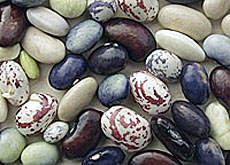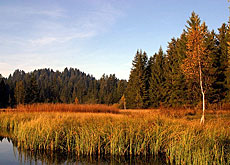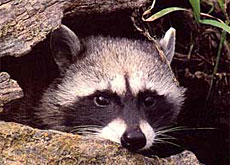Swiss safeguard future food resources

World Food Day on Saturday focused on the need to preserve domesticated species from extinction – something achieved long ago in Switzerland with seed banks.
The United Nations says that unless efforts are made globally to safeguard agricultural biodiversity, the world’s food supply will be threatened.
According to the United Nations Food and Agriculture Organization (FAO), the genetic diversity of crops has shrunk by 75 per cent over the past century.
It says food supply has become more vulnerable, and there are now fewer opportunities for growth and innovation in agriculture.
Biodiversity in Switzerland has suffered too, although it is mainly wild species of plants and animals that have been affected the most.
Eduard Hofer of the Federal Agriculture Office says domesticated plants have been better off.
“Switzerland is relatively rich in cultivated species,” he told swissinfo. “Our biggest wealth is fodder plants, because we cultivate natural meadows with many different environments and ecosystems.”
Seed banks
Plant protection has long been a Swiss priority. According to Hofer, seed banks were established over a century ago and today’s system preserves plants that are not in regular use anymore.
“Seed banks are an insurance against changing conditions, such as climate, new pests or consumer demand,” he said. “There are a variety of genes in the old plants that can be used and added to current varieties.”
The usefulness of seed banks was demonstrated recently when Japanese agronomists transplanted a little-known Swiss wheat variety, resistant to cold and wet conditions, to the northern island of Hokkaido.
Hofer says seed banks are the best way to protect plant varieties, arguing that it should not be up to farmers to cultivate old-fashioned crops.
“All these old species have lower yields than today’s varieties,” he told swissinfo. “So it is much more efficient to keep them in small quantities in a refrigerator for 20 years and call on them when we need them.”
Unpopular animals
However, agricultural domestic animals, such as cattle, pigs and goats, have not been so fortunate.
“We have been able to save a few species, but there are others that are gone forever,” said Philippe Ammann of Pro Specie Rara, an association that has promoted protection of rare breeds of plants and animals since 1982.
Today, there are 24 indigenous livestock breeds, nine of which are considered in danger, according to FAO guidelines.
While these livestock breeds are not under any immediate threat, their long-term survival is not guaranteed either.
The Federal Agriculture Office pays subsidies to breeding organisations to encourage members to rear these animals. It also organises programmes to improve the gene pool of rare livestock.
But Ammann says many older, indigenous breeds hold little commercial value for farmers.
“A farmer won’t be interested in low-production yields,” he told swissinfo. “The old breeds will only be a niche business for the mainstream agricultural community.”
But Ammann reckons there may be some changes on the way.
“Today, farming is often a second job and people don’t have as much time to look after animals,” he added. “So now they are taking a second look at the old breeds that don’t need as much care or cost as much.”
Promotion
According to Karin Wohlfender of the Federal Agriculture Office, the old breeds need to be promoted differently to ensure their survival.
“We have to make them useful in people’s eyes,” she said. “Perhaps we must use them like a brand name for some regions.”
Wohlfender told swissinfo that these animals had a number of strong selling points, including being particularly well adapted to the regions where they live.
But it may not be their capacity to adapt to conditions or their economic value that will save them: culture may play a bigger role at the end of the day.
“Cultural values do much to protect species,” said Ammann. “You can’t imagine a cow parade in Appenzell without a local goat in front of the herd.”
swissinfo, Scott Capper
There are 24 breeds of original or indigenous breeds of Swiss agricultural domestic animals, nine of which are considered endangered.
There are over 16,000 species of indigenous plants, including more than 10,000 fodder plants.
Pro Specie Rara was created in 1982 to promote the interests of rare plants and animals.
The FAO estimates that about three-quarters of the genetic diversity of agricultural crops have been lost over the last century.
Out of 6,300 animal breeds, 1,350 are endangered or already extinct.
More than 840 million people remain hungry around the world.
Global efforts have so far been insufficient to reach the Millennium Development goal of reducing the number of hungry by half by 2015.

In compliance with the JTI standards
More: SWI swissinfo.ch certified by the Journalism Trust Initiative


You can find an overview of ongoing debates with our journalists here. Please join us!
If you want to start a conversation about a topic raised in this article or want to report factual errors, email us at english@swissinfo.ch.